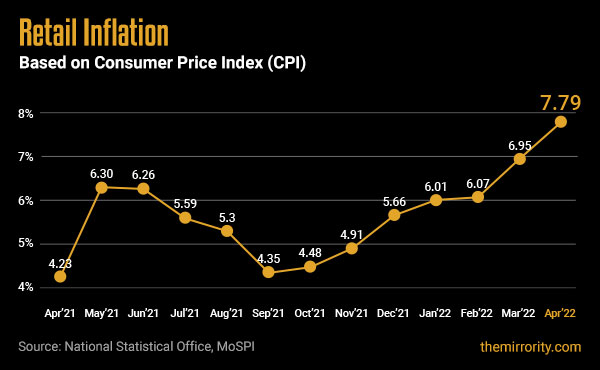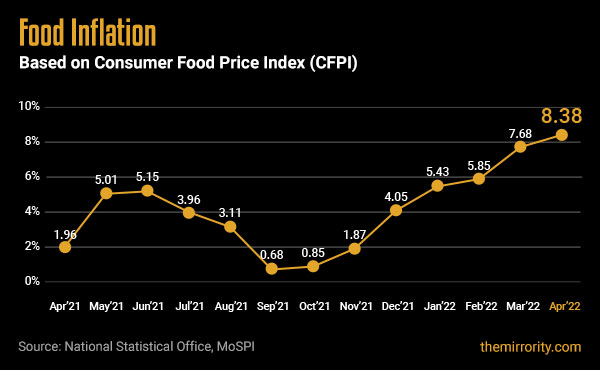
Retail inflation in India, measured by the Consumer Price Index (CPI) increased to an 8-year high of 7.79% in April, based on the latest data released by the government. The rising inflation levels seem to indicate that producers have begun to pass on the increasing cost of commodities to the end consumers.

At 7.79%, retail inflation in April has kept above the RBI’s comfort boundary of 6% for the fourth consecutive month. The core inflation, which excludes prices of volatile commodities such as food and fuel, also rose by 6.8% in April.
The RBI, in an unscheduled and surprise move on May 02, announced a 40-basis-point hike in the benchmark policy repo rate. The RBI Governor Shaktikanta Das said that the RBI’s Monetary Policy Committee (MPC) had decided unanimously to increase the repo rate to 4.40 percent from the record low of 4 percent maintained over the last 20 months. The move is expected to increase the interest rate charged by the banks to its borrowers. Accordingly, EMIs for loans are expected to rise in the coming weeks. The MPC is scheduled to next meet on June 6-8. Analysts expect the repo rate to be further raised by another 20-25 basis points leading up to a total hike of 75-100 basis points by the end of the current financial year, given the significant upside risks from rising inflation.
"The sharp spike in inflation in April explains the out of turn rate hike by RBI," said Rajani Sinha, Chief Economist, CARE Ratings. "With global turmoil continuing and commodity prices remaining high, there will continue to be upward pressure on inflation in the coming months. With concerns on the second-round effect of inflation and wage-price spiral caused by high household inflationary expectations, the RBI will be on tenterhooks," she added.

Higher inflation levels due to price increases were felt particularly in Transport & Communication, which comprises 7.6% of the overall weight in the consumer price basket, with a 10.91% increase in April. Fuel & Light recorded a price rise of 10.80% in April, in comparison to 7.52% in March. These categories have the potential to exert cost pressure on various other input items. Inflationary pressure in Housing too inched higher from 3.38% in March to 3.47% in April.
Food Inflation
Food Inflation, determined by the Consumer Food Price Index (CFPI), measures changes in retail prices of food items consumed by the population. CFPI commodities comprise 39.05% of the entire CPI basket.

Food inflation rose to a 17-month high of 8.38% in April, a sharp incline from 7.68% in March. The rise in April's food inflation is a result of an increase in the prices of almost all food items. Prices of edible oil climbed by 17.28% amid the Russia-Ukraine conflict as Ukraine is a major exporter of sunflower oil. Prices of vegetables increased by 15.41%, and meat and fish increased by 6.97%.
| Also read: Retail inflation statistics and expert analysis |
States-wise Inflation
.jpg)
West Bengal recorded the highest level of increase in retail prices at 9.12% in Apr'22, closely followed by Madhya Pradesh at 9.10%. Retail price pressure was the lowest in Kerala at 5.08% followed by Tamil Nadu at 5.37%.
Reference Reading
What is retail inflation?
Retail inflation, also called consumer inflation, is a general rise in prices of consumer goods where a unit of currency effectively buys lesser goods and services, resulting in an overall drop in purchasing power in an economy over a period. More commonly, people refer to inflation as "the rising cost of living". A prolonged period of inflation occurs when a nation's money supply growth outpaces economic growth. Generally, people's perspective on Inflation differs based on their economic position. Those with tangible assets, like property or commodities, may prefer some level of inflation as that raises the value of their assets. People holding cash may not like inflation, as it erodes the value of their cash holdings. A country always aims to maintain an optimum level of inflation to promote spending to a certain extent instead of saving, thereby nurturing economic growth. In India, the Reserve Bank of India (RBI) uses consumer inflation as a key measure of inflation to set the monetary and credit policy.
How is retail inflation calculated?
Consumer inflation is based on the Consumer Price Index (CPI). It measures the weighted average of prices of a basket of 260 goods and services which are of primary consumer needs, such as food, transportation, education, fuel, etc. Changes in the CPI are used to assess price changes associated with the cost of living. Prices of sample goods and services are collected every month from 1000-1200 urban markets and villages by field staff of the Field Operations Division of NSO, MoSPI, and the change, if any, is noted. The annual percentage change in a CPI is used as a measure of inflation. Consumer price changes in India can be very volatile due to dependence on energy imports, the uncertain impact of monsoon rains on its large farm sector, difficulties transporting food items to market because of its poor roads and infrastructure, and high fiscal deficit.
The CPI basket comprising 260 commodities including certain services is grouped under 11 heads - their weightage in the basket is mentioned in brackets: Food and beverages (45.86%), Transport and communication (8.59%), Health (5.89%), Education (4.46%), Housing (10.07%), Fuel and light (6.84%), Clothing and footwear (6.53%), Pan, tobacco and intoxicants (2.38%), Household goods and services (3.80%), Recreation & amusement (1.68%), Personal care and effects (3.89%).
Example of Retail Inflation
Let's assume 1 kg of apples cost ₹ 10 in the year 2000. Thus, ₹100 could have fetched 10 kgs of apples. In the year 2020, 1 kg of apples cost ₹20 whereas ₹100 could fetch only 5 kgs of apples. Although the value of the ₹100 note remained the same, it lost its purchasing power by 50% over the 20-year period. This phenomenon is called inflation. However, it is not necessary that prices always rise with time as they may remain steady or even decline. Using the same example above, if the price of apples is reduced to ₹5 per kg in 2020, the same ₹100 note could fetch 20 kgs of apples. In this case, the purchasing power of the ₹100 note increased over the period as the price of the commodity declined. This phenomenon is called deflation and is the opposite of inflation.
TO READ THE FULL ARTICLE

Get full access to the exciting content on The Mirrority by logging in
Support independent journalism
Even the very best of media houses in our country today are yielding to the pressure of click-bait journalism in order to survive. More than ever before, our country needs journalism that is independent, fair and non-pliant to the bureaucracy. Such journalism needs the support of like-minded readers like you to help us survive editorially and financially.
Whether you live in India or India lives inside you, help us continue to produce quality journalism with your contribution.
CONTRIBUTE
